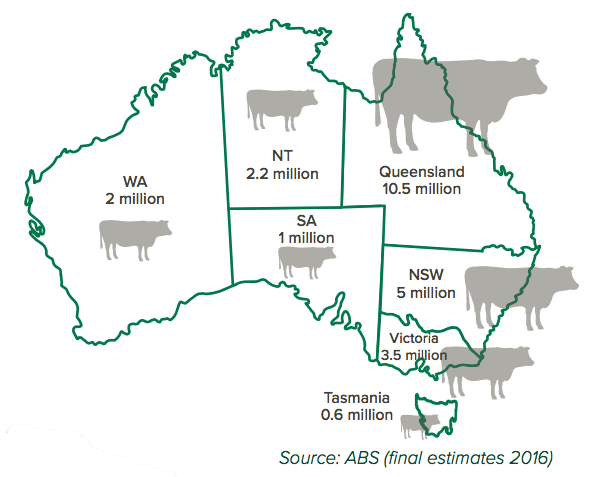Past the Basics: Advanced Techniques for Breeding and Taking Care Of Constance Cattle
Past the Basics: Advanced Techniques for Breeding and Taking Care Of Constance Cattle
Blog Article
Master the Art of Cooking With Yard Fed Meat
In the world of cooking competence, understanding the art of food preparation with grass-fed meat holds a prestigious setting. From the tender appearance to the durable taste profile, grass-fed meat provides a canvas for culinary creative thinking.
Advantages of Grass-Fed Meat

When picking grass-fed meat, customers can gain from its greater degrees of omega-3 fats and antioxidants compared to conventionally increased meat. Constance Cattle. Omega-3 fats are important nutrients that support brain health, decrease inflammation, and promote heart health. Grass-fed meat is known to have up to five times more omega-3 fatty acids than grain-fed meat, making it a healthier selection for those wanting to boost their intake of these useful fats
In addition to omega-3 fatty acids, grass-fed meat is also richer in anti-oxidants such as vitamins E and C, as well as beta-carotene. Anti-oxidants play an essential duty in safeguarding cells from damages triggered by cost-free radicals, which can contribute to various persistent conditions and speed up aging. By choosing grass-fed meat, consumers can not just take pleasure in a more flavorful and nutrient-dense healthy protein source but additionally support their total health and wellness and health.
Including grass-fed meat right into your diet can be a basic yet reliable means to enhance your dietary intake and enjoy the benefits of omega-3 fats and antioxidants that are normally plentiful in this kind of meat.
Finest Food Preparation Approaches
Utilizing appropriate food preparation approaches is necessary to maintain the nutrient account and improve the taste of grass-fed meat. When cooking grass-fed meat, it is crucial to keep in mind that it is leaner than traditionally increased meat, making it much more susceptible to drying if overcooked. To guarantee a juicy and flavorful end result, consider cooking grass-fed meat at slightly lower temperatures than you would with grain-fed meat.
Barbecuing is a prominent approach for food preparation grass-fed meat as it enables excess fat to trickle away, stopping flare-ups that can trigger charring. When grilling grass-fed meat, use tool warm and keep a close eye on it to stop overcooking. An additional wonderful food preparation technique for grass-fed meat is pan-searing. This method assists secure in the juices and create a delicious crust on the meat.
Sluggish cooking techniques such as braising or stewing are also exceptional alternatives for harder cuts of grass-fed meat, as they help damage down the muscle mass fibers and tenderize the meat. Whichever food preparation method you pick, bear in mind to allow grass-fed meat remainder after preparing to permit the juices web to redistribute, ensuring a damp and tender final dish.
Taste Pairings and Seasonings
To boost the all-natural tastes of grass-fed meat, critical taste pairings and flavorings play a crucial duty in elevating the general dining experience. Grass-fed meat has a rich, distinct taste that can be complemented and enhanced by thoroughly chosen active ingredients.
Along with natural herbs, seasonings such as black pepper, garlic, and smoked paprika can even more raise the taste profile of grass-fed meat meals. These spices give a balance of heat, sweetness, and smokiness that can improve the overall eating experience. When seasoning grass-fed meat, it is vital to use premium salt, like sea salt or Himalayan salt, to draw out the meat's tastes without adding unneeded chemicals or additives.
Storage and Dealing With Tips
Proper storage and handling methods are essential for keeping the high quality and quality of grass-fed meat. When storing grass-fed meat, it is important to keep it cooled at temperatures listed below 40 ° F(4 ° C) to stop bacterial development and spoilage. To extend the meat's shelf life, consider covering it snugly in parchment paper or butcher paper prior to putting it in an impermeable container or secured plastic bag - Constance Cattle. Stay clear of storing grass-fed meat near strong-smelling foods as it can take in odors conveniently.
When taking care of grass-fed meat, it is essential to practice great hygiene to avoid cross-contamination. see this page Wash your hands thoroughly prior to and after managing the meat, and make sure that all utensils and surfaces that come into call with the meat are cleaned up and disinfected effectively. In addition, use different reducing boards for meat and veggies to prevent microbial transfer.

Top Grass-Fed Meat Recipes
When taking into consideration the ideal means to savor the high quality and freshness of grass-fed meat, exploring top-notch recipes can raise your cooking experience. Grass-fed meat's abundant taste and leaner profile provide themselves well to a variety of dishes that highlight the all-natural benefits of the meat.
If you remain in the state of mind for something lighter, a Grilled Grass-Fed Hamburger served with fresh garnishes and a side of pleasant potato french fries is a delicious choice. Furthermore, a Herb-Crusted Grass-Fed Shelf of Lamb baked to perfection with a medley of natural herbs and breadcrumbs is a show-stopping recipe for special events. These leading grass-fed meat recipes display the flexibility and premium high quality of grass-fed meat, enabling you to appreciate its remarkable taste in various culinary basics productions.
Conclusion
To conclude, understanding the art of cooking with grass-fed meat uses various advantages, consisting of enhanced dietary worth and superior flavor. By utilizing the best cooking techniques, trying out flavor pairings and flavorings, and complying with appropriate storage space and taking care of pointers, you can produce nourishing and scrumptious dishes. Check out some top grass-fed meat dishes to boost your culinary abilities and appreciate the complete potential of this top notch active ingredient.
When cooking grass-fed meat, it is vital to keep in mind that it is leaner than traditionally increased meat, making it more susceptible to drying out if overcooked. To ensure a juicy and savory result, consider cooking grass-fed meat at slightly lower temperature levels than you would with grain-fed meat.
When seasoning grass-fed meat, it is essential to use high-grade salt, like sea salt or Himalayan salt, to bring out the meat's tastes without adding unneeded chemicals or ingredients.
Grass-fed meat's abundant taste and leaner profile lend themselves well to a selection of meals that highlight the all-natural goodness of the meat. These leading grass-fed meat dishes showcase the adaptability and premium top quality of grass-fed meat, enabling you to enjoy its exceptional taste in various cooking productions.
Report this page